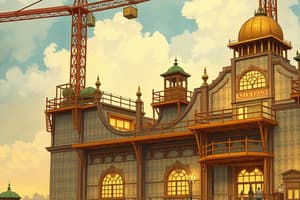Podcast
Questions and Answers
Who is defined as a competent person according to the OSHA Construction Standard?
Who is defined as a competent person according to the OSHA Construction Standard?
- Someone with a college degree in engineering
- Someone with basic first aid training
- Someone capable of identifying workplace hazards and authorized to take corrective measures (correct)
- Someone with at least 5 years of experience in construction
In what circumstances may a competent person determine that a protective system is not required for trenches?
In what circumstances may a competent person determine that a protective system is not required for trenches?
- If the trench is 10 feet deep
- If the trench is 20 feet deep
- If the trench is less than 5 feet deep (correct)
- If the trench is in stable rock
When are trenches required to have the protective system designed by a registered professional engineer?
When are trenches required to have the protective system designed by a registered professional engineer?
- If the trench is 20 feet deep or greater (correct)
- Always
- Only if the trench is in unstable soil
- If the trench is 15 feet deep
What is the responsibility of employers regarding the inspection of trenches according to OSHA standards?
What is the responsibility of employers regarding the inspection of trenches according to OSHA standards?
What is a competent person responsible for in trenching operations?
What is a competent person responsible for in trenching operations?
According to OSHA standards, when should trenches and protective systems be inspected?
According to OSHA standards, when should trenches and protective systems be inspected?
What type of soil is Type A according to OSHA classification?
What type of soil is Type A according to OSHA classification?
What are examples of Type B soils according to OSHA classification?
What are examples of Type B soils according to OSHA classification?
What is the responsibility of a competent person in the context of safety rules?
What is the responsibility of a competent person in the context of safety rules?
What is emphasized as a part of the job in the context of common sense safety rules?
What is emphasized as a part of the job in the context of common sense safety rules?
What is recommended regarding safety procedures and equipment in the context of common sense safety rules?
What is recommended regarding safety procedures and equipment in the context of common sense safety rules?
What is advised in case of not understanding safety procedures?
What is advised in case of not understanding safety procedures?
What is warned against in the context of common sense safety rules?
What is warned against in the context of common sense safety rules?
What is discouraged in the context of common sense safety rules?
What is discouraged in the context of common sense safety rules?
What is highlighted as the responsibility of an individual if they see an unsafe act or situation?
What is highlighted as the responsibility of an individual if they see an unsafe act or situation?
Flashcards are hidden until you start studying
Study Notes
OSHA Construction Standard: Competent Person and Trenching Operations
- A competent person is defined as one who is capable of identifying existing and predictable hazards in the surroundings, or working conditions that are unsanitary, hazardous, or dangerous to employees.
Circumstances for Protective System in Trenches
- A competent person may determine that a protective system is not required for trenches if the trench is less than 5 feet deep or is benched to a stable angle, among other conditions.
Designing Protective Systems
- Trenches over 20 feet deep require a protective system designed by a registered professional engineer.
Employer Responsibilities
- Employers are responsible for inspecting trenches as often as necessary to ensure they are safe.
Competent Person Responsibilities
- A competent person is responsible for inspecting trenches, ensuring safe entry and exit, and determining whether a protective system is required.
Inspection of Trenches
- Trenches and protective systems must be inspected daily, before the start of work, and after any changes or environmental changes.
OSHA Soil Classification
- Type A soil is classified as "stiff clay, very stiff clay, hard clay, or rocky soil that is very difficult to penetrate".
Type B Soils
- Examples of Type B soils include stiff soils, very stiff soils, hard soils, or rocky soils that are difficult to penetrate.
Responsibility of a Competent Person
- A competent person is responsible for ensuring that safety rules are followed, identifying hazards, and taking corrective action.
Common Sense Safety Rules
- Following safety procedures and using personal protective equipment (PPE) are emphasized as part of the job.
- It is recommended to review and understand safety procedures and equipment before starting work.
- If unsure about safety procedures, ask for clarification or guidance.
- Do not take unnecessary risks or shortcut safety procedures.
- Do not ignore or disregard safety rules.
- If an individual sees an unsafe act or situation, they should alert the competent person or supervisor.
Studying That Suits You
Use AI to generate personalized quizzes and flashcards to suit your learning preferences.




